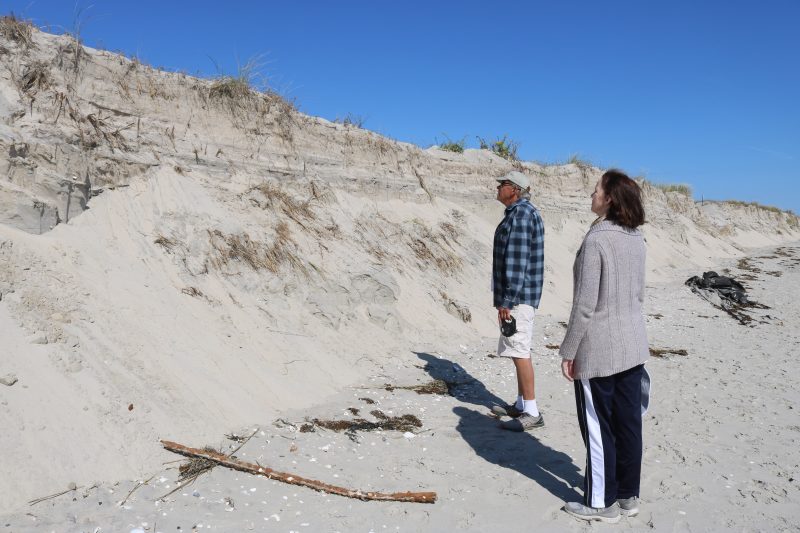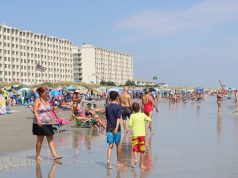By DONALD WITTKOWSKI
For seven minutes and 32 seconds, viewers can watch a YouTube video shot by Sue Williamson showing rough surf relentlessly pounding the eroded beach and dunes around 88th Street in Sea Isle City.
It is a startling reminder of just how vulnerable the beach can be to the whims of the stormy ocean.
Williamson, who has lived full-time on 85th Street for almost five years, says it is the worst beach and dune erosion she has ever seen in the south end of Sea Isle stretching all the way to Townsends Inlet at 94th Street.
“What really concerns me is how bad it is in Townsends Inlet and how many trees we’ve lost there. That has a ton of erosion,” she said of the Townsends Inlet Waterfront Park overlooking the channel that connects the bay and ocean.
(Video courtesy of Sea Isle City resident Sue Williamson)
The erosion will probably get worse in February as winter weather continues to churn up the surf. But, fortunately, it will definitely get better starting in March or April.
This spring, the U.S. Army Corps of Engineers will begin a much-awaited beach replenishment project to restore the storm-damaged shoreline in two sections of Sea Isle.
In all, 252,000 cubic yards of new sand will be placed between 29th and 52nd streets in the mid part of the island and another 388,000 cubic yards between 74th and 94th streets in the south end.
A floating dredge anchored offshore will collect sand from the sea bottom and pump it onto the beach through a massive pipe network.
“(We) are looking forward to replenishment of our beaches this coming spring. The most recent update we have on the project is that we can expect the arrival of the dredge Liberty Island in late March/early April, with completion of beach-fill operations prior to Memorial Day weekend,” Mayor Leonard Desiderio said in the latest update on the project.
The U.S. Army Corps of Engineers, a federal agency, will oversee the beach replenishment project.
Steve Rochette, a spokesman for the Army Corps, confirmed in an email Friday that work will begin in March or April and should be done by Memorial Day, in time for the start of the busy summer tourism season.
Rochette noted that beach replenishment projects are a vital way to protect shore communities from the damage inflicted by coastal storms.
“The purpose of these projects is to maintain the beach berm system and repair dunes in some cases. Having a functional berm and dune system in place is important to absorb energy from waves during storm events. It reduces the risk of storm damage to physical infrastructure such as homes, roads, utility lines, promenades, etc.,” he said in the email.

Sea Isle is part of a $33.7 million project that also includes replenishing the storm-damaged beaches and dunes in the southern end of Ocean City and Strathmere. Sea Isle has approved a $3.2 million funding package to pay for its share of the project.
Beach replenishment projects are primarily funded by the federal government through the Army Corps of Engineers. Under the funding formula, the federal government kicks in 65 percent of the cost, while the New Jersey Department of Environmental Protection and the towns that are getting their beaches replenished subdivide the remaining 35 percent.
The midsection of Sea Isle from about 29th to 57th streets and the southern tip of the island from 74th to 94th streets typically suffer erosion during the stormy fall and winter seasons.
Williamson is intimately familiar with the condition of the beaches near her house on 85th Street close to Townsends Inlet. She frequently walks the beaches.
In summer, Williamson serves as the director of Sea Isle’s family-friendly beachcombing tours that educate the public about the shore’s fragile eco-system. She is also a retired schoolteacher and a member of Sea Isle’s Board of Education.
Her YouTube video of the beach erosion at 88th Street was shot in January. It dramatically shows the waves washing over the beach all the way to the dunes.
Viewers can see bits of sand disappearing in the surf, along with trees and other vegetation on the edge of the eroded dunes tumbling into the water.
Williamson said the beach erosion is so severe next to the Townsends Inlet Bridge and the Townsends Inlet Waterfront Park that it’s a “strange daily occurrence.”
“It comes and goes fast there,” she noted of the beach sand.

In some spots at the south end of the island, the dunes have been carved away by the stormy weather, leaving steep sand cliffs about 10 to 20 feet high in their place.
As a temporary measure, the city has done “sand harvesting” at different times to fortify the depleted dunes mainly between 88th and 92nd streets. Essentially, sand was scrapped from the water’s edge and pushed up against the dunes by earthmovers.
But Williamson’s video shows that much of the harvested sand has since been washed away.








